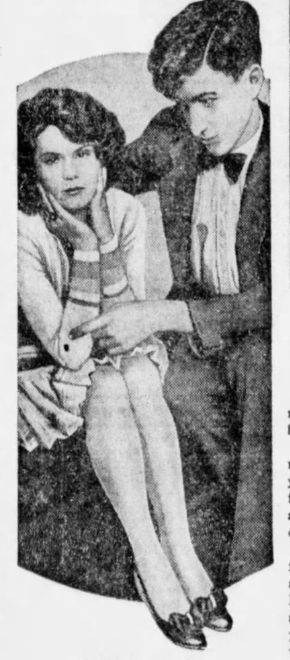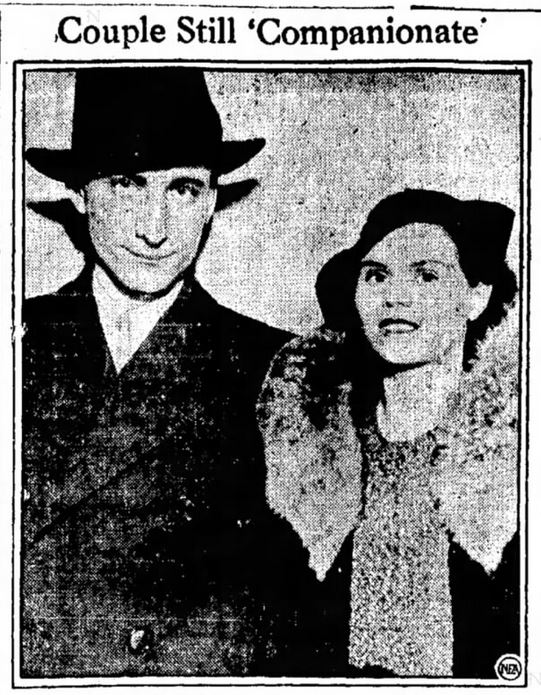On November 22, 1927, the grand-niece of Jane Addams was married at her home in Girard, Kansas. Josephine Haldeman-Julius, the daughter of Marcet and Emanuel Haldeman-Julius, was joined in a “companionate” union to Aubrey Clay Roselle. The couple’s marriage was a rather sudden one, given their decision to marry only solidified a few months prior. Even by early twentieth century standards in the United States, the couple was considered rather young to marry. Josephine Haldeman-Julius was only just completing her last year of high school, while Roselle was working on his second year at the University of Kansas.
-

Minnesota Star Tribune, March 22, 1936,. p. 65.
The wedding had originally been planned for Thanksgiving Day, November 25. News of this matrimony, however, garnered the interest of motion picture photographers who intended to crash on the wedding and film it. So, in hopes of preserving their privacy the family moved the wedding day up. The union was considered and widely publicized as one of the first companionate marriages in the history of the country. Newspapers from the East to the West coast featured the union of Haldeman-Julius and Roselle. For those uncertain as to what a companionate marriage entailed The Brooklyn Daily Eagle quoted the “bride’s father” as stating it was a marriage with “no children until after his daughter completes her education. That if the young people do not wish the relationship to be permanent, they will seek a divorce and that the husband will not be expected to support his wife. He added, however, if there were a child the marriage would become a ‘family’ instead of a ‘companionate’ union.” Companionate marriage served as a more flexible arrangement of marriage because there were no obligations of starting a family immediately.
Companionate marriage was a term popularized by Judge Ben B. Lindsay in his 1927 book of the same name. This type of marriage embraced a modern egalitarian idea, where couples controlled their fertility and rejected patriarchal family models, envisioning marriage as an equal partnership committed to the fulfillment of each individual’s emotional and sexual needs. (Davis, 1140). In concluding the ceremony between Josephine Haldeman-Julius and Aubrey Roselle, the officiating minister, Reverend L. W. Birkhead, pastor of the Unitarian Church in Kansas City, concluded, “I pronounce that you are husband and wife in the name of all that is good and true and beautiful. . . May your companionship be congenial and mutually inspiring and may you have in it a safe refuge in all the storms and stress of life…” (Bridgeport telegram)

Still only eighteen years old, Josephine Haldeman-Julius wished to pursue a career in dancing and theater. Not wanting to be tied to the home, but also not wanting to wait for marriage, she saw companionate marriage as an obvious solution. According to the St. Louis Post-Dispatch, Haldeman-Julius remarked, “It seems almost too beautiful to be true to me that we shall be free to enjoy each other completely, and yet not have to give up school and the careers we have both planned.”
It seems suiting that a marriage of this kind was created from the great niece of one of the United States most influential women, Jane Addams. Probably one of the most significant role models for Josephine Haldeman-Julius was her mother. Jane Addams’ niece, Marcet Haldeman-Julius, juggled her responsibilities as not only a mother, but also an editor, actress, women’s rights activist, and banker. Like her mother, Josephine kept her maiden name and hoped to succeed in the theater.
After their marriage, Haldeman-Julius and Roselle continued living with their parents and worked towards their careers in dancing and law. Only after Roselle began his career and became financially independent did they plan to move in together. This was quite different from the traditional route of marriage, in which financial independence came first (at least for the men), and then was followed by marriage proposals, matrimony, and a family. The success of this marriage was highlighted nearly a decade later in an article by the Albuquerque Journal titled, “Experts Gloat, Sound Warnings, as Young Marriages Show Signs of a Comeback.” Published in March of 1936, the news article described the Haldeman-Julius-Roselle couple as “happy as Adam and Eve before the Fall.”

Sadly, however, the marriage did not last. The couple divorced in 1944. In 1945, Aubrey married Ann Harriet Peck, and shortly afterwards they had two children, David and Elizabeth Ann. Aubrey Roselle died in 2000. In 1946, Josephine married Samuel Griff. She died in 1998.
“Experts Gloat, Sound Warnings, as Young Marriages Show Signs of a Comeback.” Albuquerque Journal, March 15, 1936. Accessed December 1, 2018.
Davis, Rebecca. “‘Not Marriage at All, but Simple Harlotry.’: The Companionate Marriage Controversy.” The Journal of American History 49, no.4 (2008): 1137-1163. Accessed November 28, 2018.
“First Companionate Pair Are Told by Minister They Are Bound by Love.” The Brooklyn Daily Eagle, November 23, 1927. Accessed December 2, 2018.
“Best Man and Maid of Honor Absent at Contract Wedding.” The Bridgeport Telegram, November 23, 1927. Accessed December 2, 2018.
Pair Marries On Companion Basis Before Date Set.” St. Louis Post-Dispatch, November 22, 1927. Accessed December 1, 2018.
Our thanks to Aubrey Roselle’s daughter, Betsy Roselle Sumner, for details on his second marriage.


Just to add that actually Aubrey had 4 children with second wife Ann Roselle. Betsy, David, Larry, and Patty.
Thanks, Betsy!